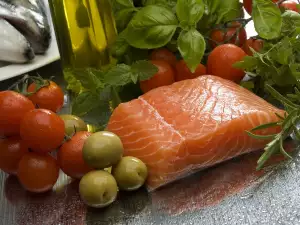Purslane (Portulaca oleracea) is an annual plant from the Portulacaceae family. It's also known as pigweed, little hogweed, red root, pursley. It has a climbing, succulent and branching stem, which can reach up to 20″ (50 cm) long. The lower leaves of the herb are alternately arranged and the upper ones are opposite. All of them are spade-shaped, fleshy and shiny.
The flowers of purslane are small, single sessile or clustered in 2s or 3s along the branches of the stem. The fruit of the plant has an obovate shape. The seeds are black and bean-like.
Purslane is found in West and Eastern Europe, Central Asia, South America, Iran. Often it thrives near roads, fences and vineyards.
History of Purslane
No one knows for sure when purslane was first used. In the 8th century BC, the plant was mentioned in a letter as an herb from the garden of Babylonian king Marduk-apla-iddina II. In the 16th century the herb was mentioned in a book of herbs, where it was recommended for the treatment of stomach acids. The author of the book claimed that regular rinsing with the juice from purslane helped against tooth mobility (loose teeth).
Composition of Purslane
The leaves of the herb are rich in vitamin A, B6, as well as 7-8 times the amount of vitamin C found in citrus fruits. Purslane contains iron, calcium, sodium, magnesium, phosphorus, manganese, omega-3 fatty acids and other beneficial substances.

Collecting and Storing Purslane
Purslane grows along plains and semi mountainous areas. It is collected during bloom - from July to October. The aboveground part is cut off and cleaned. It's best to dry it out in the open, shuffling it periodically.
Finish drying it in ventilated and sunny areas of temperatures up to 120°F (50 °C). 15.5 lb (7 kg) of fresh purslane yield 2 lb (1 kg) of dried. It's important to dry the herb quickly since slow drying lowers its quality. Dried stalks of the plant should have retained their natural appearance. The only difference should be a light paling of the flowers.
Benefits of Purslane
In folk medicine, remedies from purslane are used as a laxative and diuretic substance. It aids vision, regulates blood sugar. Recent research by American scientists shows that the plant has beneficial effects on diabetes, heart attack, light burns and cancer diseases. It is good for the cardiovascular and hormonal systems. Purslane is recommended for eye inflammation, cysts, cystitis, prostatitis, fungal infections and obesity.
Arabic healers use the herb to treat headaches, stomach problems, enterocolitis. Topically, it helps treat wounds, psoriasis and blisters. This miraculous plant heals practically all kinds of illnesses, which was why the ancient Arabs called it a blessed vegetable.
Culinary Use of Purslane

Purslane is considered a weed in some regions of the world, although in others it's eaten as a leaf vegetable. It's advised to eat it fresh. Its young leaves have a slightly sour and salty taste, while the older leaves are tart. The leaves of the plant make for delicious and very healthy salads, which are then further seasoned with olive oil, garlic, dill, lemon juice and parsley.
Purslane Salad
Ingredients: 10.5 oz purslane, 10.5 oz tomatoes, 2 bunches green garlic, 1 cup flax sprouts, 1 bunch dill, 2 tbsp olive oil, 1 pinch salt, 5.5 oz cottage cheese.
Preparation: Clean the purslane of the thick stems, soak it in salted water and chop it along with the tomatoes and garlic. Add the sprouts, chopped dill and cottage cheese. Season with the spices and stir.
Purslane is also an excellent substitute for lettuce, spinach, dock and sorrel. Besides to make salads, it's used in soups, spaghetti, rice dishes, pitas and phyllo pastries; even in tarator with walnuts instead of using cucumbers. It combines excellently with cottage cheese, feta and cheese. The juice of purslane is a fantastic vitamin bomb.
Folk Medicine with Purslane
In the ancient past, the herb was used to strengthen the body after a serious illness. It was said that purslane tea could cleanse the blood.
Purslane concoctions were used to treat gynecological disorders, migraines, arthritis, stomach acid and gastritis.
To make a tea, pour 1 cup boiling water over 1 tbsp of the herb. Let it cool and strain. Drink it once a day.
The plant can be used to make a homemade anti-dandruff lotion, by pouring 1 cup boiling water over 1 tbsp of the dried herb. Let the mixture cool and rub into the scalp after showering.
Besides medicinal, the wonder-herb is also rejuvenative. A facial mask made of 2 tbsp of dried purslane and 1 tsp oat flour makes wrinkles less visible, it nourishes and tones facial skin.
















